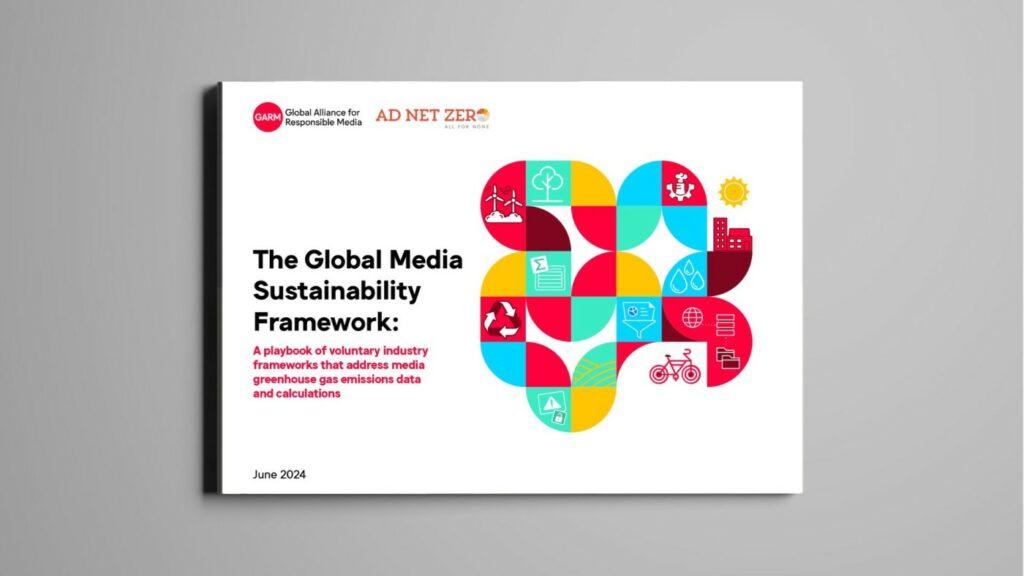
The Global Media Sustainability Framework is a cross-industry collaboration between WFA’s Global Alliance for Responsible Media (GARM) and the Ad Net Zero community. It allows advertisers, media owners and agencies to measure across six major media types.
Ad Net Zero (ANZ) has published the first iteration of its Global Media Sustainability Framework – a series of voluntary industry standards to improve consistent, comparable measurement of greenhouse gas emissions from digital, television, print, audio, outdoor and cinema channels. The new framework has been supported by a collection of the world’s largest advertisers, as well as the world’s 6 largest advertising holding companies, major media owners, tech companies and trade bodies, many of whom have contributed to its development (listed below).
The framework is the outcome of a 12-month, GARM-led global engagement effort to build a series of common measurement processes and includes the first versions of formulae, as well as tools to help efficiently collect emissions data from companies throughout the media supply chain. Up until now, there has been no consistent, agreed industry-wide measurement framework.
The goal is to help every advertiser and their partners understand and take positive action to reduce the carbon impact of their media plans – in line with Action 3 of the Ad Net Zero Action Plan.
The work has been supervised and assessed for consistency with best carbon accounting practices by a Climate Science Expert Group including representatives from PwC, Brain Oxygen, Climate Impact Partners, BL Evolution and top climate experts from Unilever, Reckitt, and Diageo. A key foundation for the development of the formulae used in the framework has been provided by the Oneframe Initiative in France, with specific components provided by SRI, Alliance Digitale, SNPTV and UPE.
What is being released today
The first versions of formulae being released are for TV, digital and OOH(representing 81% of global 2023 ad spend according to Magna), with the formulae for the remaining three media types – audio, print and cinema – to follow. It is expected that the formulae will continue to be refined.
In addition to the formulae for six media channels, the new framework provides the industry with:
- A common enterprise level data request form for more efficient data collection of company data from media sellers, with more specific channel level data being required in the framework over time.
- A disclosure form for the industry to understand the scope, data rigour and scientific validation of media sustainability solutions providers.
- A voluntary monitoring template to help GARM and ANZ learn about the adoption and effectiveness of the frameworks.
What next?
The next phase of work for GARM and Ad Net Zero will be to establish an efficient system to transfer emissions data between buyers and sellers, followed by validation of media GHG data using agreed industry voluntary standards. Uptake and adoption will be tracked, with the first results published in Q2 of 2025.
How each part of the global advertising industry can play a key role in driving this framework forward:
- Advertisers are asked to check that the partners who measure GHG emissions from their media activities are using the Global Media Sustainability Framework.
- Agencies can ensure their own tools or partners are using the Global Media Sustainability Framework and make GHG emissions a consideration for all media plans.
- Media owners can supply the requested data to advertisers, agencies and other solutions providers in as much granularity as possible, continually improving the quality of this data over time.
How the framework was created:
Six cross-industry working groups – supported by the Responsible Marketing Agency (RMA) – have produced this comprehensive set of voluntary standards to help reduce varying approaches to measurement, data and reporting. This approach has ensured widespread support and action across the industry, with 70% of responding organizations saying they plan to implement the voluntary standards in ways that are relevant to their media operations.
Commentary from Ad Net Zero Community
Sebastian Munden, Chair, Ad Net Zero: “Today’s release of standard calculations for the carbon footprint of major media channels is a significant milestone for Ad Net Zero and the global ad industry. They are the starting point for creating a common currency for global voluntary adoption: a base for calculating reduction and accelerating progress. Concerted efforts to reduce the carbon footprint of media should go hand in hand with the efforts to support more sustainable choices to change the way we work and change the work we make. The ad industry has the business opportunity of a generation to be part of the solution.”
Rob Rakowitz, Initiative Lead, Global Alliance for Responsible Media: “We are proud to support Ad Net Zero and help the group to create an essential foundation for the industry to benchmark their activities. We are hopeful that this work stemming from our uncommon collaboration will allow industry stakeholders to pursue a larger transformation in voluntarily reducing emissions stemming from media campaigns.”
Marla Kaplowitz, President and CEO, 4A’s: “The 4A’s is proud to support the new GARM/ Ad Net Zero media measurement frameworks for establishing carbon emissions footprints for TV, digital, print, OOH, audio and cinema channels. »
Bob Liodice, CEO, ANA: “The ANA is proud to support the marketing industry’s collective advancement toward a common measurement framework for emissions reduction through Ad Net Zero and GARM. We will continue to collaborate with industry associations, brands, and partners to lower marketing’s environmental impact through the Global CMO Growth Council and ANA Sustainability Committee.”
Arthur Millet, General Manager, Alliance Digitale: “The GARM framework represents a significant step towards making digital marketing more sustainable. At Alliance Digitale, we embarked on this journey two years ago with the SRI, aiming to create a unified measurement framework for digital carbon emissions. We are excited to see that the SRI x Alliance Digitale framework has served as a crucial foundation for a worldwide solution. A lot has been accomplished, and there’s still work to do. We believe that sustainability is primarily about collaboration, and we would like to thank GARM for facilitating this. We hope we will continue this collaborative work for the next steps.”
Dr Bill Wescott, Chair, Climate Science Expert Group, Brain Oxygen: “This framework, paired with production emissions standards like AdGreen and verified enterprise level emissions inventory reporting across the ad sector, enables advertising firms to be aligned with their stakeholders’ needs, particularly advertisers who are already following established climate standards for all other activities. Like current climate standards with continuous improvement processes, we are counting on fact-based feedback from those implementing this initial version so that future versions will be even more accurate and practical.”
Isabel Massey, VP of Media, Connections & Content, Diageo:“Diageo recognizes the urgency of a standardized framework to measure media carbon emissions across the industry, and we see it as a key step in reducing carbon footprint.”
Tamara Daltroff, CEO, EACA: “This Framework was urgently needed and is a great achievement for media agencies and the advertising industry. It has been an intense journey to get to today’s point. It is now up to advertisers, agencies and media owners to make the best use of it. At EACA, we encourage collaborative, positive action towards reducing carbon footprint. It is good to see the industry coming together as a lot still needs to be done.”
Michael Todd, Global Director, Industry Relations, Google: “We are proud to have worked closely with the GARM and ANZ community to arrive at this important milestone. Standardization is a vital component in driving the industry towards making more sustainable media choices and bringing more clarity to this area is an important achievement. This has been a true team effort and we are excited to continue to work with GARM, Ad Net Zero and our partners to contribute to the next stage in this process to further refine the framework.”
Stephanie Betrand-Tassilly, Global Chief CSR Officer, Havas:“Working with our peers to define a common carbon metric makes perfect sense. At Havas, we’re already measuring the carbon impact of our creative, events and media campaigns, but today we want to go further, to work towards a set of industry standards. Collaboration is key and will enable us to accelerate the decarbonization of the advertising sector.”
Dagmara Szulce, Global Executive Director, IAA: « At IAA, we are committed to fostering industry collaboration to drive positive change. The partnership between Ad Net Zero and GARM marks a significant milestone in advancing the sustainability agenda, and we are proud to support and amplify this important framework globally. »
David Cohen, CEO, IAB: “IAB and its members support and applaud the collaborative efforts of Ad Net Zero, WFA and all the companies who have worked diligently to develop clear guidance on a decarbonization framework for the advertising and marketing industries. The climate crisis is an acute challenge for us all, and while we work towards a coordinated global effort, standards and guidelines are critical to ensure we are all approaching the challenge with uniformity.”
Townsend Feehan, CEO, IAB Europe: “IAB Europe is proud to support the Global Media Sustainability Framework developed by the Global Alliance for Responsible Media (GARM) and Ad Net Zero. Through our Framework & Methodology Working Group – an integral part of our Sustainability Standards Committee – we have collaborated closely with National IABs and corporate members to contribute feedback and expertise towards shaping the digital aspect of the framework. The ambition underlying our extended involvement in GARM and Ad Net Zero’s work tracks is that these standards will guide the industry towards more sustainable practices. »
Nigel Gwilliam, Director of Media Affairs, IPA: “We very much welcome the new Global Media Sustainability Framework. Having agreed standards for calculating media supply chain emissions is the cornerstone of decarbonising commercial media. The UK was the launch market for Ad Net Zero and we intend to continue the pioneering spirit by developing a next generation, framework-compliant IPA media carbon calculator for the UK market. There are considerable lessons to be learned from putting theory into practice and we expect all markets globally to benefit from this.”
Martin Bryan, Global Chief Sustainability Officer, IPG Mediabrands: “With this new framework we can begin to work with our valued media partners and vendors to track the environmental impact of media campaigns with clear and consistent industry metrics. Thanks to the work of WFA, GARM and Ad Net Zero, this will allow us to continue the critical work of reducing the climate impact of media campaigns on behalf of our clients.”
Phil Smith, Director General, ISBA: « We’re delighted to see the fruits of this massive collaboration and support the framework. Advertisers have been clear about the need for rigour and consistency in the measurement that will help them reduce their emissions from media. This is a major step forward. »
Kim Dirckx, Global head of Sustainability, Strategic Partnerships & Innovation, L’Oréal: « At L’Oréal we have a long-standing commitment to Sustainability, setting our first SBTI commitments in 2015, resubmitting our commitment in Q4 2023 earning the badge of the SBTI Net Zero Standard. Digital decarbonization will be crucial to reach these commitments. However, we can’t do this alone. As Digital Sustainability is still nascent, we need strong partners that are willing to collaborate, so that together we can develop measurement tools, reduction levers and a clear roadmap towards decarbonization. We have found this partner in Ad Net Zero and GARM and look forward to this continued partnership. »
Hervé Navellou, President of L’Oréal France. President of the Union des Marques: « The publication of the Garm/AdNetZero framework is an essential step to take concrete action on the carbon emissions of communication campaigns. I am happy to have been one of the initiators of the Oneframe initiative in France with L’Oréal France, which is one of the foundations of this approach. I encourage all actors to seize this opportunity to implement global and local decarbonization management of their media campaigns on all identified levers, whether from the point of view of asset size, media mix or planning. »
Cheryl Guerin, EVP, Global Brand Strategy and Innovation, Mastercard: « It is the responsibility of the entire media ecosystem to take bold and collective action in reducing our carbon footprint. Aligning around a standardized framework will help effectively measure, manage, and reduce greenhouse gas emissions across all major media types, paving the way for a sustainable advertising future.”
Christy Cooper, Global Director of Industry Relations, Meta:“We are proud to be part of GARM and Ad Net Zero’s work to unify the industry around a global ads emissions measurement framework. We are committed to working with the industry and will be kicking off a process to evaluate solutions to provide this data to advertisers in the future as GARM’s framework evolves.”
Stephanie Helen Scheller, Managing Partner Sustainable Solutions, Omnicom: “The standardization of carbon metrics and measurement is a groundbreaking step for the industry to drive forward the sustainable transformation of our industry. It is a great example of how the industry no longer wants to accept the status quo and is preparing to face the challenges of tomorrow. I am proud and grateful to be part of this movement and the collaborative work we’ve created so far.”
Nannette Lafond-Dufour, Chief Impact Officer, Publicis Groupe:“This new Global Media Sustainability Framework is a key step in understanding and calculating emissions from media in a standardized and transparent way. All partners, wherever they are in the supply chain, will have the opportunity to understand their environmental impact and reduce it. We completely support this work and are looking forward to the next stages in this collaborative partnership.”
Johanna Bauman, CMO, PubMatic: “PubMatic is proud to have been an active member of the Ad Net Zero community since 2022. We were excited to partner with our peers from across the ecosystem on the development of this global media sustainability framework and look forward to helping our industry build a more responsible, sustainable digital advertising supply chain.”
David Croft, Group Head of Sustainability, Reckitt: « We’re pleased to be part of Ad Net Zero & members of WFA and welcome this voluntary global framework with consistent to measure our media planning & buying emissions. We’ll work with our partners to reduce carbon emissions in advertising as part of our net zero ambition. »
Prasad Ghag, Global Media Head, Consumer Healthcare & Anna Kechekmadze, Global Digital Lead, Sanofi: “We started our decarbonization journey beginning of last year through a simple but robust approach to measure- reduce – offset. Addressing the 1st step of ‘measure’ was the most critical part to understand the quantum of challenge. From our numerous tests through multiple solutions to measure carbon – it was clear – we needed an industry benchmark and a set of principles to bring a standardized approach. And that’s where GARM has been so effective in bringing all the parties together – advertisers, platforms, agency partners, sustainability experts – to create that one direction for us all. We at Sanofi CHC are proud to be part of the team in creating this approach, while also learning through the process. This is now our key objective to measure all our digital campaigns’ carbon footprint across the world and leveraging this framework will be key in delivering on this ambition.”
Antoine Ganne, Managing Director, SNPTV: “The GARM framework is a true milestone in the media industry’s commitment to a more sustainable advertising model. At SNPTV, we started this journey 2 years ago with our common framework for TV emissions measurement and we couldn’t be happier to see our initiative followed and enhanced at an international scale. We thank the GARM for this opportunity to share our work and take part in these exciting discussions. We hope this framework will help all members of our industry to engage in a harmonized monitoring of advertising campaigns.”
Corinne Mrejen, Managing Director & Chief Impact Officer Les Echos Le Parisien Medias, President of SRI (Syndicat des régies internet): “We are proud that France is leading the way in environmental policy making which applies equally to advertising and media industry. By developing in 2021 the first methodological framework for carbon measurement of digital campaigns in collaboration with major market players and Alliance Digitale, we had the opportunity to share our works & contribute actively GARM media measurement initiative. Having a global and aligned measurement methodology will definitely give new momentum to our collective commitment for a more sustainable future, shaping new practices and behaviours.”
List of Supporting Companies
- 4As
- The Advertising Association (AA)
- Alliance Digitale
- ANA
- Diageo
- dentsu
- EACA
- GroupM
- Havas
- IAA
- IAB
- IAB Europe
- Indeed
- IPA
- IPG
- ISBA
- L’Oreal
- Omnicom
- Publicis Groupe
- PubMatic
- Mastercard
- Meta
- Sanofi
- SNPTV
- SRI (Syndicat des régies internet)
- Reckitt
- Unilever
- Union des Marques
- World Federation of Advertisers (WFA)
Interested in a copy of the framework? Click here.


